Understanding the Bitcoin Mining Rig Market
Introduction
It’s a natural progression for many people going down the bitcoin rabbit hole to become interested in mining and generating discounted BTC cash flow. Historically, it has also been natural for people to run into a giant obstacle when trying to actually buy the bitcoin mining rigs and make that dream a reality.
With all of the major ASIC (Application Specific Integrated Circuit, the name of specialized bitcoin mining computers) manufacturers based in China and deals often being brokered through random Telegram channels, the prospect of spending tens of thousands of dollars on some mining rigs can be intimidating. For a lot of prospective miners, even finding a reputable ASIC broker among the sea of scammers and shady operators is an ordeal.
At MiningStore, we’ve helped deploy and distribute over 30k bitcoin mining rigs since 2017. Our team maintains a constant finger on the pulse of the mining hardware market and understands the logistics better than anybody.
Our aim is to help demystify the complex world of purchasing and deploying ASICs so that you can confidently start and scale up your bitcoin mining operations.
Understanding the Bitcoin Mining Rig Market
Breakdown of ASIC Manufacturers (Past, Present, and Future)
The first thing to understand when you’re learning to navigate the mining rig market is how to choose an ASIC hardware manufacturer. While all of the manufacturers today are based out of China, there are still some substantial differences between them that can impact your operation long-term.
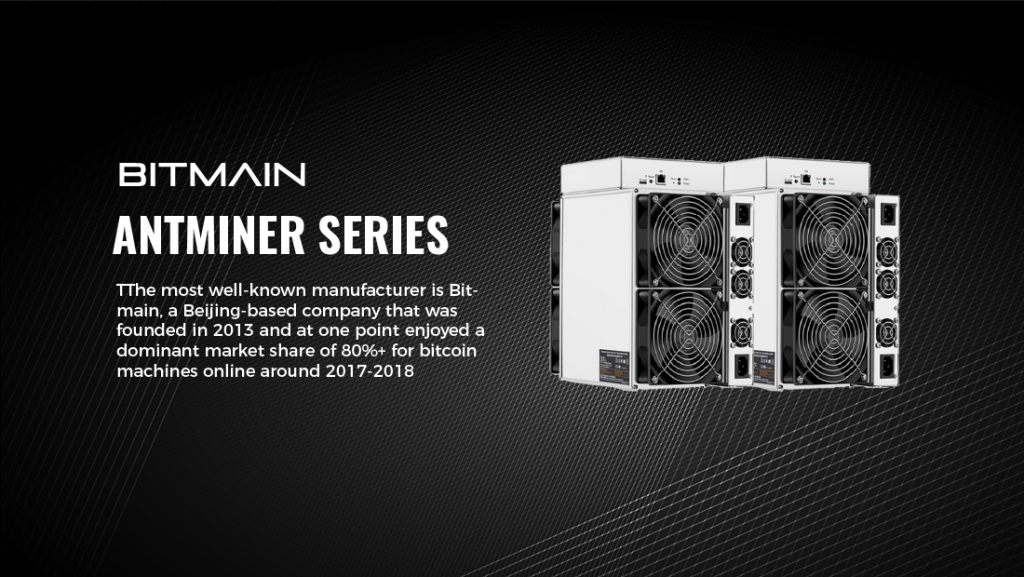
Bitmain (Antminers)
The most well-known manufacturer is Bitmain, a Beijing-based company that was founded in 2013 and at one point enjoyed a dominant market share of 80%+ for bitcoin machines online around 2017-2018. Bitmain’s 2016 release, the Antminer S9, redefined ASIC lifespans from the 6-12 months that was customary in the early days of ASICs (2013-2016) to the 5+-year lifespans that are customary today.
In fact, there are still hundreds of thousands of Antminer S9’s operating around the world today. Since these machines are now relatively inefficient (about 3x less efficient than new-generation mining rigs), the majority of them have found their way to places with very cheap power but much higher risk of international shipping and security, such as Venezuela, Argentina, and Iran.
Meanwhile, Bitmain has had two more high-profile releases to date: the Antminer S17-generation in 2019 and the Antminer S19-generation in 2020. Although the efficiency improvements from the S17-generation to the S19-generation were not as large as the S9-to-S17 jump, the actual difference in performance between these two families of mining rigs is enormous.
From the very first months of deliveries, miners were reporting extremely high failure rates of over 30% for all the Antminer S17-generation models, which include the base S17, S17+, S17 Pro, T17, and T17+, as well as the S17e and T17e. The malfunctions were primarily a result of using low quality manufacturing techniques and materials to attach the heat sinks to the hashboards which contain the actual mining chips. Since newer bitcoin ASICs consume upwards of 3000 Watts each, they produce an incredible amount of heat. Dissipating that heat and moving it away from the mining chips is a huge component of ASIC hardware architecture and—to put it simply—Bitmain really failed with that 2019 release.
However, the Antminer S19-generation has thus far been a redemption story for Bitmain. Failure rates are back below 2% and there isn’t a significant backlog of warranty claims as there was for the S17’s. Bitmain is still shipping out thousands of new Antminer S19 models each month, including sub-models such as the S19 Pro, S19j, S19j Pro, and T19. Given the significantly improved reliability of these new-generation ASICs, they are the main Bitmain machines that we recommend and sell to our clients at MiningStore.
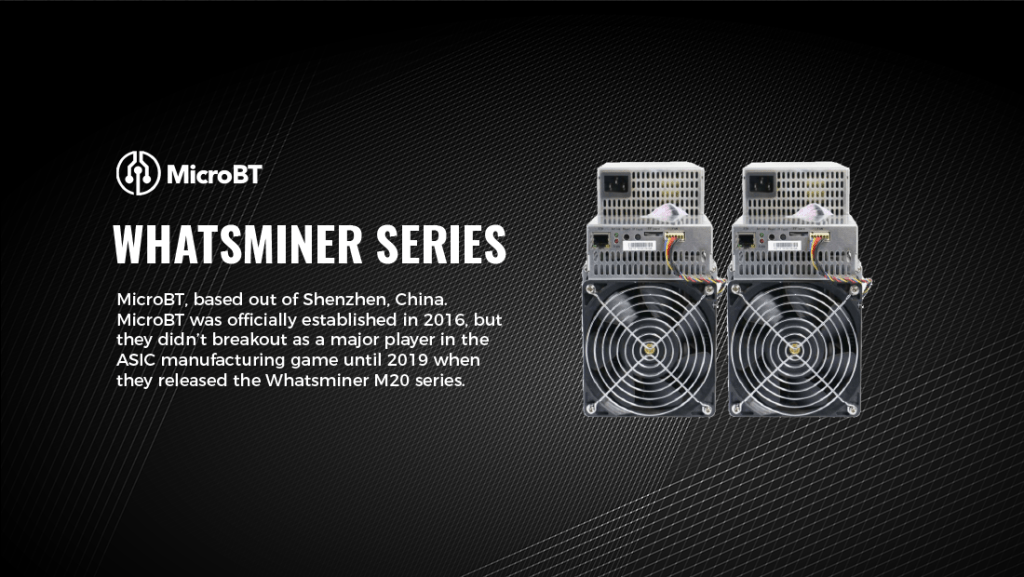
MicroBT (Whatsminers)
Right on Bitmain’s heals with the 2nd-largest market share for bitcoin machines is MicroBT, based out of Shenzhen, China. MicroBT was officially established in 2016, but they didn’t breakout as a major player in the ASIC manufacturing game until 2019 when they released the Whatsminer M20 series.
Up until the M20 release, the Antminer S9 was indisputably the most durable and reliable bitcoin mining rig ever built. Nowadays, the Whatsminer M20S has a legitimate claim to that title, having very low failure rates and maintaining its long-term efficiency for multiple years with over 600k units operating around the world.
Interestingly, the chief hardware architect of the Antminer S9, Dr.Yang Zuoxing, is also the founder of MicroBT. It’s likely not a coincidence that Bitmain encountered serious problems with the Antminer S17-generation and lost more than 30% of their market share for bitcoin ASICs after Dr. Yang’s departure.
Like Bitmain, MicroBT released a new generation of hardware in 2020 with the Whatminer M30 series, which includes the Whatsminer M30S, M31S, M32S, M30S+, M31S+, and M30S++. This family of machines has thus far proven to have similarly high quality as the M20 series and is a solid competitor to the Antminer S19 family. At MiningStore we sell both the Whatminer M20 and M30 series of hardware.
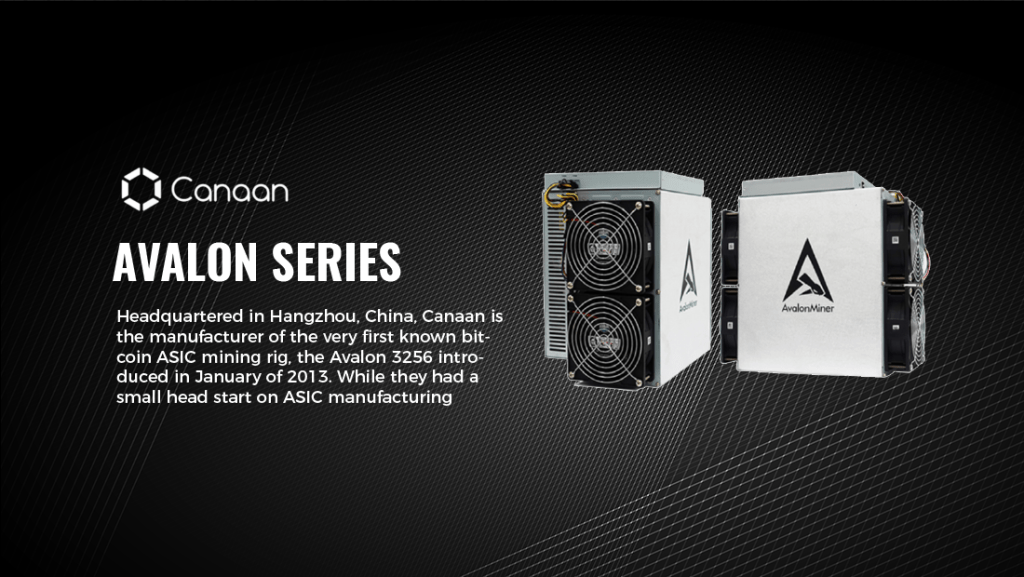
Canaan (Avalon Miners)
Headquartered in Hangzhou, China, Canaan is the manufacturer of the very first known bitcoin ASIC mining rig, the Avalon 3256 introduced in January of 2013. While they had a small head start on ASIC manufacturing, Bitmain eventually overtook Canaan and left them with a relatively small market share below 10% in the modern mining era.
Canaan’s latest mining rig, the Avalon 1246, is competitive with the Antminer S19 and Whatsminer M30S families in terms of hashrate and efficiency. By most accounts, the hardware is typically solid and recent generations have had good durability and lifespan.
However, the more common issues for Avalon miners stem from the relatively small market share of the machines and sometimes buggy firmware (i.e. the operating system of the miner). With fewer machines out there, particularly in western markets like Europe and North America, there are fewer qualified repair technicians, custom firmware alternatives, and fluent English-speaking support agents.
In other words, if you get a good piece of hardware and don’t make any mistakes deploying it, you’ll be mining competitively with the Antminers and Whatsminers of the world. On the other hand, if something goes wrong you might have a slower resolution process.
Other ASIC Manufacturers
Between the three of them, Bitmain, MicroBT, and Canaan account for more than 95% of bitcoin’s total network hashrate. Other companies who have manufactured bitcoin mining machines include Innosilicon, Ebang, and Bitfury, but since these ASICs are much less common we don’t deal with them or recommend them to our clients.
One of the big questions about the future of the ASIC hardware market is whether or not a bitcoin ASIC manufacturer might emerge outside of China. Mining hardware is extremely capital-intensive to manufacture and requires years of research and development to make a competitive product. It’s likely that some companies are working on solutions quietly right now, and will make them public only once they confirm that they are viable and competitive.
One company to keep an eye on in this field is Canada-based Blockstream, who announced their acquisition of an altcoin mining hardware manufacturer called Spondoolies and are now working on their bitcoin ASICs. That said, the anticipated release of Blockstream’s first mining rig is not until Q3 2022, and it will likely be relatively small scale in the beginning.
Bitcoin ASIC Efficiency and Hashrate
When it comes to actually picking and purchasing your ASIC mining hardware, there are a few basic metrics that you need to be aware of.
The most important metric about any given mining rig is its hashrate, measured in terahash/second (TH/s). This tells you how many computations the machine can perform, which directly correlates to how much bitcoin it will earn. The hashrate of mining rigs has increased very quickly over the years, from 10-15 TH/s in 2016 to over 100 TH/s for the highest-performance machines today.
Along with hashrate, another extremely important detail about your bitcoin machines is their power consumption, measured in Watts. This must be taken into account when planning how many mining rigs you can fit into your given power capacity. For example, if you have 1MW of available power, you could fit about 280 Antminer S19’s which consume 3250W each at manufacturer settings (leaving a safety margin and some power capacity for cooling). Alternatively, you could go with an older machine like the Antminer S9 with 1200W consumption per rig, and then you’d fit closer to 800 of those machines.
Finally, by putting these two metrics together, we get ASIC efficiency. This metric is measured in either Watts/Terahash (W/TH) or Joules/Terahash (J/TH), but both numbers are the same. The best ASICs in 2021 have efficiencies around 30 W/TH, such as the Antminer S19 Pro with 29.5 W/TH and the Whatminer M30S++ with 31 W/TH. Mid-generation mining rigs like the Antminer S17 and Whatsminer M20S have efficiencies in the 40-60 W/TH range, while old-gen machines like the Antminer S9 typically operate around 80-90 W/TH.
Something to note is that none of these metrics are fixed when you purchase mining machines. ASIC firmware, which is like the operating system of the device, allows you to customize your power consumption.
Generally, when you increase the power consumption above default settings, the result is an increase in hashrate but a decrease in ASIC efficiency. This is called overclocking and it’s a very common practice when mining profitability is high, as it enables you to earn more revenue per mining rig that you run.
It’s also possible to lower the power consumption of the machines, thereby decreasing the hashrate but increasing the efficiency. This is called underclocking or undervolting, and it is a common strategy when mining with old-generation machines like the Antminer S9 to keep them profitable even while competing with the best new-generation ASICs.
The reason that ASIC efficiency responds this way to changes in power consumption is that the operational efficiency depends strongly on the effectiveness of heat dissipation. Consuming more power means that the ASICs produce more heat, and if the machines get too hot they can no longer hash effectively. An emerging technology in this space is immersion cooling, in which mining rigs are submerged in a coolant that has a far greater thermal capacity than air and can therefore cool the ASICs faster. This is gaining popularity in hotter climates such as Texas and the Carolinas in the USA, and it’s one of the things we can discuss with you via our Remote Hands program.
Measuring ASIC CapEx in $/TH
Before you purchase bitcoin mining hardware, you should also understand the framework commonly used in the industry for valuing machines. The critical metric here is dollars per terahash ($/TH), which tells you the size of the CapEx (capital expenditure) relative to the revenue potential of the machine. In other words, $/TH is like your up-front cost vs. the expected amount of BTC mined by that mining rig.
The SHA-256 Rig Index on hashrateindex.com is a great resource for visualizing how the ASIC market is changing over time with BTC price fluctuations and changes in network difficulty. It shows historical $/TH figures for each generation of ASICs, as well as specific $/TH charts for popular machines like the Antminer S19 and Whatsminer M30S.

We can determine the expected price of an ASIC by multiplying the $/TH for its respective efficiency bracket by the hashrate of the machine. For example, an Antminer S19 valued at $100/TH will likely sell for approximately $9,500 per unit since it has a hashrate of 95 TH/s. Of course, prices per mining rig typically decrease the larger your order quantity, meaning that your $/TH should be lower if you purchase 100 machines instead of 10.
In the short- and medium-term, ASIC hardware prices are mostly dependent on BTC price, while network difficulty increasing causes machines to depreciate slowly over time. It used to be (in 2013-2016) that bitcoin mining rigs could go obsolete in 6-18 months as new, more efficient rigs were manufactured. In recent years, ASIC lifespans have increased dramatically, and it’s now expected that most mining rigs will have 5+ years of profitable mining.
Due to rising BTC price and severe supply chain shortages for semiconductor chips used in ASICs, every generation of bitcoin mining hardware has increased significantly in value over the course of 2021. If significant BTC price appreciation occurs, we would expect to see mining rigs reach all-time high values in terms of $/TH.
How to Estimate Bitcoin Mining Cash Flow
Now it’s time to put everything together and develop an example business plan for a bitcoin mining operation. The first big decision, of course, is which mining rigs to buy. This is all about balancing your up-front CapEx with your ongoing OpEx to maximize mining profitability and longevity.
Since bitcoin mining is extremely energy-intensive, your electricity costs are likely to account for the majority of your operating expenses. The typical electricity price range offered by bitcoin mining hosting services today is 5-7 ¢/kWh, so for our example analysis we will use the average of that range: 6 ¢/kWh.
At this price range, mid- and new-generation mining rigs are your best bet. Since the mid-gen Antminer S17 models are unreliable, we’ll analyze the Whatsminer M20S for a lower CapEx option and the Antminer S19 for the lower OpEx option.
Example Whatsminer M20S Profitability Analysis
According to Hashrate Index, the price of an M20S in October, 2021 is about $4,850 with specifications of 68 TH/s and consumption of 3360 W. For a 5 MegaWatt operation filled to 90% capacity (leaving a 10% safety margin), we could fit 1339 Whatsminer M20S machines.
Whatsminer M20S | ||
Single Rig | 5 MW Facility | |
# of units | 1 | 1339 |
Hashrate (TH/s) | 68 | 91071 |
Consumption (W) | 3360 | 4500000 |
Efficiency (W/TH) | 49 | 49 |
CapEx ($/TH) | 71 | 71 |
CapEx ($ Total) | 4850 | 6495536 |
Now plugging these numbers into a bitcoin mining profitability calculator, we can project future cash flow. This requires making some assumptions about what will happen with BTC price and difficulty, as well as the hardware value over time. In order to be extremely conservative, we can keep BTC price constant while increasing difficulty by 5% per month and assuming ASIC hardware depreciation of 2% per month. This gives us the following results.
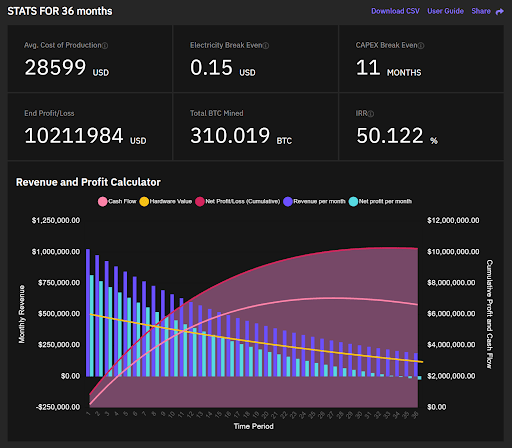
Custom inputs for Whatminer M20S and constant BTC price
Some important things to notice:
- Even without any BTC price appreciation and a 5% monthly difficulty increase, we would break even on the hardware purchase in 11 months.
- The operation remains profitable at 6 ¢/kWh until Month 34, at which point we could liquidate the hardware for approximately $3MM.
- We mine 310 bitcoins at an average cost of about $28.6k over the 3-year lifetime of the operation, a more than 50% discount from the market price of $57k at the time of the analysis.
The success of this operation even in a highly conservative scenario of constantly increasing difficulty with steady price shows why so many investors want exposure to bitcoin mining. It’s not easy to set up and run a large operation (which is where our Remote Hands and Managed Mining Programs can help), but the upside is huge.
And to give some better insight on that upside, let’s also look at the performance of this same operation with BTC price increasing by 3% per month (still slower than difficulty) and holding 50% of the mining profits in BTC to keep exposure to this upside.
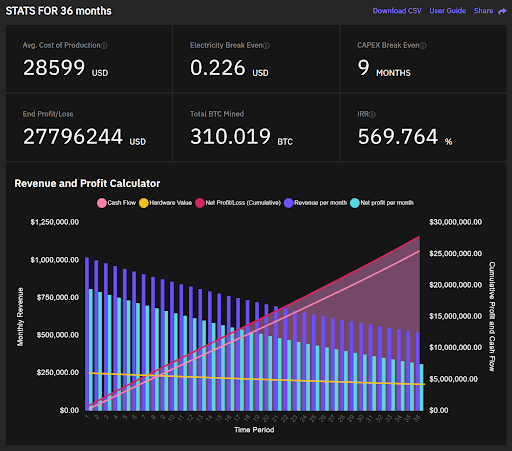
Custom inputs for Whatsminer M20S with BTC price increasing
We mine the same amount of BTC at the same discounted rate of $28.6k on average, but our CapEx break even occurs 2 months earlier and our end profit nearly triples thanks to the gains made from holding 50% of the BTC we have left after paying our bills. On top of that, we are still making over $300k in profit per month by Month 36, and our mining rig inventory would certainly retain more value thanks to the higher bitcoin price.
That’s the lower CapEx and higher OpEx version, but now let’s see what it looks like if we take a bigger up-front risk by purchasing more efficient Antminer S19’s.
Example Antminer S19 Profitability Analysis
With efficiency of 34 W/TH, Antminer S19’s are on the more expensive end of the spectrum for bitcoin mining hardware. The $/TH is $105 as of October 2021, for a total machine cost of approximately $10k because the S19 specifications are 95 TH/s and 3250 W.
Antminer S19 | ||
Single Rig | 5 MW Facility | |
# of units | 1 | 1385 |
Hashrate (TH/s) | 95 | 131538 |
Consumption (W) | 3250 | 4500000 |
Efficiency (W/TH) | 34 | 34 |
CapEx ($/TH) | 105 | 105 |
CapEx ($ Total) | 10000 | 13846154 |
Plugging in these inputs along with the same price and difficulty as we analyzed for the Whatsminer M20S, we get the following results.

Custom inputs for Antminer S19 and constant BTC price
Big takeaways:
- This operation breaks even in Month 18, 7 months slower than with the Whatsminer M20S operation due to the much higher initial CapEx investment to buy the mining rigs
- We mine an additional 137 BTC compared to the M20S operation in the 3-year time period
- Our average cost to mine 1 BTC is under $20k
- We remain profitable for the entire time duration analyzed even without any BTC price appreciation
This highlights the risk-reward tradeoff involved in choosing your bitcoin mining machines. The return on investment is actually smaller with the Antminer S19 in this case without any BTC price appreciation. However, we would expect to see increasing BTC price disproportionately benefit the miner with more efficient machines and higher hashrate. So now let’s check with the 3% price appreciation and 50% of profits held in BTC.
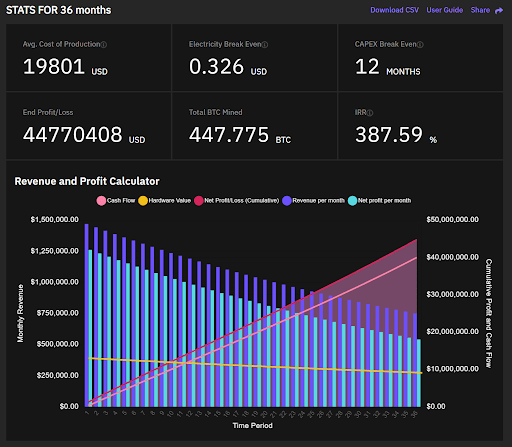
Custom inputs for Antminer S19 and increasing BTC price
Now the Antminer S19 is our clear winner. The end profit of nearly $45MM is $18MM higher than the Whatsminer M20S analyzed with the same price and difficulty increases. It only takes 1 year to break even on the mining rig investment and the net profit per month is $540k even at the end of the analysis in Month 36.
How to Purchase Bitcoin Mining Rigs
Hopefully, this has given you a good understanding of the bitcoin ASIC market and calculating mining profitability with all of the unpredictable variables involved. That said, we know that it can take some time to adjust if you’re a beginner to bitcoin mining. Our team of experts has been navigating the mining rig market for years and are here to help you with selecting, purchasing, and deploying your own miners. We look forward to hearing from you!